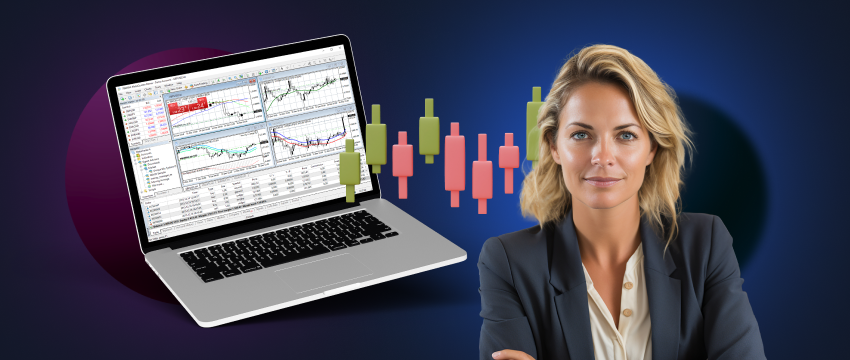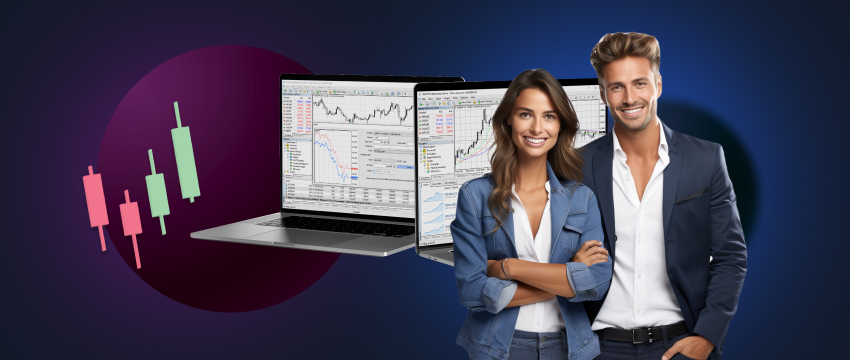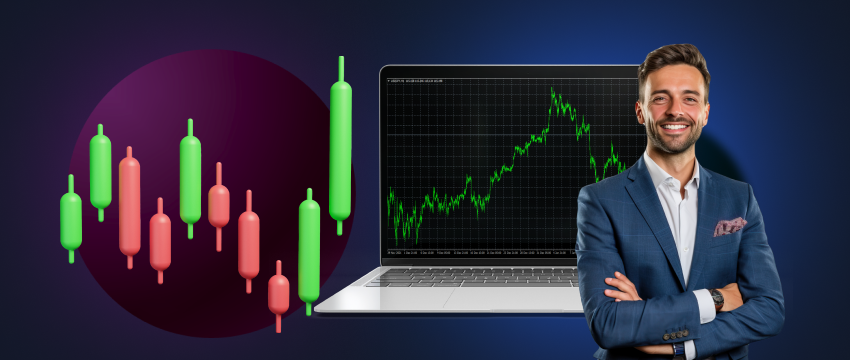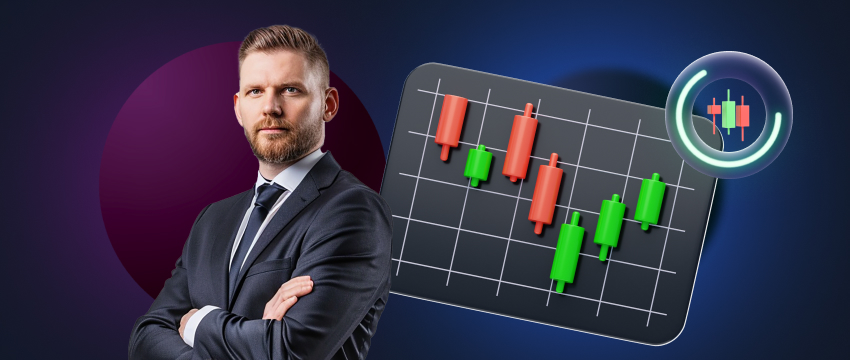Traders range from large financial institutions and international corporations to individual retail traders. To increase the likelihood of achieving gains, these traders will use several trading strategies, tools, or techniques. In this blog, we’ll explore some of the key approaches executed by forex traders to maximize trading opportunities.

Trading strategies
Forex traders make use of a variety of strategies to generate profit. Some of the most popular trading strategies include:
1. Scalping
A scalper trader will attempt to make small profits from multiple trades within a trading day. They will hold onto positions from seconds to minutes to capitalise on small price changes. The decision to use scalping as a strategy is often made based on the premise that:
- Reduced adverse market exposure limits the probability of risk such as loss of capital.
- Smaller price moves are easier to exploit and occur more frequently than larger price moves.
- Scalping generally requires smaller amounts of trading capital per trade in comparison to say swing trading.
2. Day trading
Like a scalper, a day trader doesn’t typically hold positions overnight or after hours. Instead, they enter and exit positions before the market closes, to avoid any risk. Traders use day trading as another popular strategy to gain from short-term price movements, avoiding long waiting periods.
3. Swing trading
Unlike scalping or day trading, swing trading is a longer term trading approach. A swing trader will usually hold onto positions for several days to weeks to profit from medium-term price movements. Reasons why retail traders may opt for swing trading:
- Due to its nature (longer time frame), constant monitoring of positions isn’t critical.
- Traders can automate the strategy and set stop-loss orders themselves.
- It may require less upfront capital.
4. Position trading
Position trading is by far the longest-term approach. This type of traders will hold positions for weeks, months or even years. They tend to use fundamental analysis to make trading decisions, while not completely disregarding テクニカル分析. Character traits of a position trader include:
- The ability to remain patient and calm.
- Having a good understanding of fundamentals.
- You have the necessary capital and don’t mind waiting for potential gains.
Technical analysis
Most short-term trading strategies use technical analysis to improve financial outcomes and make gains. Technical analysis involves analyzing historical price charts and using various tools and indicators to forecast future price movements. It is comprised of several key activities like:
- Chart analysis to visualise price movements. Some popular charts include line charts, bar charts, candlestick charts, etc.
- Identifying trends, momentum, and potential reversal points using テクニカル指標 like moving averages, MACD, RSI, Bollinger Bands, etc.
- Recognising chart patterns to gain insights into possible price movements, and to make informed decisions.
- Identifying support and resistance levels to set entry and exit points.
Fundamental analysis
Traders adopting longer-term trading approaches tend to make use of fundamental analysis to determine trade execution. They will monitor economic indicators like employment rates, interest/inflation rates, GDP, retail sales, industrial production, PMI, ECI, and more. They will also consider central bank announcements and other economic releases.
Additionally, traders will monitor news events closely to anticipate market reactions, e.g., geopolitical instabilities, elections, trade agreements, and even natural disasters. A fundamental analyst will also pay attention to trader sentiment, which news and global events usually drive.
Continuous trading education
Regardless of skills or knowledge, forex traders will engage in ongoing learning. To optimise their capabilities, thereby improving their chances of making a profit. Gaining a trading related education can take on many forms, be this via podcasts, webinars, seminars, blogs, e-guides, videos, etc. In fact, most forex brokers offer their traders a wealth of free online educational resources to help improve their trading competencies.
T4Trade for example has its own academy through which traders can access a variety of material to acquire information. And widen their scope of knowledge. Designed by T4Trade’s in-house research team, every resource has been expertly curated. To help traders navigate the forex market and minimise the risks inherent in forex trading.
Also, the CFD broker also offers insightful blogs. That covers many of the most important trading fundamentals and answers frequently asked trading questions.
Complementing these resources is T4Trade’s Economic Calendar which provides real-time economic coverage enabling traders to track and react to potential market-moving events. As well as its trading calculators to help them make more accurate decisions.
In addition to conventional learning resources, signing up for a demo trading account is also an optimal way to improve one’s trading skills. CFD Traders can deploy a variety of trading strategies in a virtual trading environment to establish which one best aligns with their level of expertise, budget, and tolerance for risk. Using virtual money, they can enter and exit trades, and track outcomes using a trading journal.
They can learn how to use technical and fundamental analysis better to make more strategic trade decisions, all while keeping their own money safe. Mimicking real-life market conditions, traders get a real world feel for live trading before actually making the move to real global markets.

Famous traders who’ve amassed considerable fortunes
There are many well-known traders and investors across the globe who serve as inspiration to those new to forex trading. Many have had incredibly long careers and have significantly influenced the forex space.
George Soros
For instance, people internationally regard George Soros as the trader who reportedly broke the Bank of England in 1992. He achieved this by short-selling $10 billion in British Pound Sterling.
On 16 September 1992 the UK exited the European Exchange Rate Mechanism as it was unable to uphold the necessary trading band, primarily because of Soros’ trade. This event is famously referred to as Black Wednesday in history. So successful is Soros that his firm reportedly generated $22 billion in profit in 1998.
Jim Rogers
Jim Rogers co-founded the Quantum Fund with Soros in the early 70s which is said to have gained 4200% over ten years. He is also infamous for his accurate bullish call on commodities in the 1990s.
Richard J. Dennis, also known as the Prince of the Pit was a highly successful Chicago-based commodities broker who is said to have amassed a $200 million fortune over a 10-year period from speculating.
He’s also known for co-creating the Turtle Trading Experiment with William Eckhardt, demonstrating that anyone could learn to trade. The Turtle Trading system is also a famous trend-following strategy.
Andy Krieger
Andy Krieger is another infamous trader who quickly earned himself a successful reputation at Banker’s Trust who awarded him by increasing his capital limit to $700 million.This reportedly helped him profit from the 1987 crash known as Black Monday.
Paul Tudor Jones
Paul Tudor Jones II is best known for earning roughly $100 million by betting against stocks during the 1987 market crash, a prediction he made in a TV documentary. Reports indicate that as of 2023, Jones had accumulated approximately $7.5 billion.

Trading with T4Trade
T4Trade continues to gain popularity among global forex traders for its top-tier multi-lingual customer support team, cutting-edge trading tools, learning resources and market insights.
This is further enhanced by accessing more than 300 trading instruments across 6 asset classes, offering flexible leverage, tight spreads, fast execution, and easy deposits or withdrawals.
T4Trade also has a range of trading accounts for you to choose from so that you can enjoy trading through the globally renowned MetaTrader 4 platform.
Disclaimer: This material is for general informational and educational purposes only and should not be considered investment advice or an investment recommendation. T4Trade is not responsible for any data provided by third parties referenced or hyperlinked in this communication.




